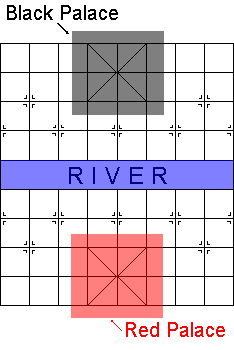Xiangqi, or Chinese Chess, is an extremely popular game in the Eastern Hemisphere. It is currently played by millions (or tens of millions) in China, Taiwan, Thailand, Singapore, Vietnam, Hong Kong and other Asian countries. Xiangqi has remained in its present form for centuries. It is believed that both Xiangqi and Orthodox Chess derive from the original Indian game of Chanturanga.
![]() (xiáng)
(xiáng) ![]() (qí
) translates to Elephant Game. In Mandarin it is written as either Xiangqi,
Xiang Qi or Hsiang-Ch`i and pronounced "Shiang-Chi". In Cantonese it is written
as Jeuhng Keih and pronounced "Junk Kay".
(qí
) translates to Elephant Game. In Mandarin it is written as either Xiangqi,
Xiang Qi or Hsiang-Ch`i and pronounced "Shiang-Chi". In Cantonese it is written
as Jeuhng Keih and pronounced "Junk Kay".
The name Xiangqi has an interesting origin. Of China's four traditional arts -- qin (music), hua (brush painting), shu (calligraphy) and qí (strategy games) -- the latter term, qi, provides the final syllable of Xiangqi. There is much literature on Xiangqi, most of it in Chinese. There are, however, a few books available in English and other languages.
Xiangqi sets can be procured from a number of sources. The most obvious of these are shops in the Chinese districts of large cities. Often, such sets are quite cheap, consisting of a paper board and flat wooden counters inscribed with red and black pictograms. These traditional Chinese symbols may appear strange to the western eye, but can easily be recognized with a minimum of practice. (For more sophisticated sets, see below.)

The above board shows various L-shaped markings in order to distinguish the setup points of Pawns and Cannons. These markings are not present on all commercial boards.
Each player has the following pieces:
| 2 Rooks | (R) | (or chariots) |
| 2 Knights | (N) | (or horses) |
| 2 Elephants | (M) | (or bishops or ministers) |
| 2 Mandarins | (G) | (or advisors or assistants or guards) |
| 1 King | (K) | (or generals) |
| 2 Cannons | (C) | |
| 5 Pawns | (P) | (or soldiers) |
The Xiangqi array is shown below:
|
|
|
|
From left to right on the bottom and top rows, you see: a Rook, a Knight, a Minister, a Guard, a King, a Guard, a Minister, a Knight, and a Rook. On the third rows, you see the Cannons, and on the fourth row you see the Pawns. Pieces at the bottom half are red. |
|
| Chinese Pieces | Movement | Westernized Pieces |
|---|---|---|
  |
RooksThe Rook moves as an orthodox Rook. (See Rook for more information.) |
  |
  |
Knights (Mao)The Knight moves one point orthogonally followed by one point outward-diagonally. It may not leap over occupied points. (See Mao for more information.) |
  |
  |
ElephantsThe Elephant moves exactly two points diagonally. It may not leap over occupied points. Also, Elephants are confined to their home side of the river. Due to these limitations, the Elephant can see only eight points of the board. (See Elephant for more information.) [The symbols on red and black Elephants differ, but their moves are the same.] |
  |
  |
MandarinsThe Mandarin (or Guard) moves one point diagonally. It may never leave the palace. [The symbols on red and black Mandrians differ, but their moves are the same.] |
  |
  |
King or GeneralThe King moves as an orthodox King, but cannot move diagonally. It may never leave the palace. (See King for more information.) [The symbols on red and black Kings differ, but their moves are the same.]The two Kings cannot face each other on an open file. For example, a red King on e1 and a black King on e9, with no piece on the e-file between them, is an illegal position. If either King sits exposed on an open file, the other King may not move to occupy that file. |
  |
  |
Cannons (Pao)The Cannon moves differently when it moves to capture than when it moves passively.
In other words, Cannons capture by hoping over a second piece in order to capture a third piece. For example, a Cannon on a1 can take a piece on f1 when exactly one of the points b1, c1, d1, or e1 is occupied by a piece of either color. Cannons only capture when hoping and only hop when capturing. They may never hop over more than one piece in a given move. (See Cannon for more information.) |
  |
  |
PawnsUnlike orthodox Pawns, the Xiangqi Pawn's passive move and capture move are always the same. A starting Pawn moves one point straight-forward. A Pawn crossing the river promotes, keeping its old move and gaining a new move -- a one-point step to either horizontal. Pawns do not promote on the last rank, where they can move only left or right. (See Xiangqi Pawn for more information.) [The symbols on red and black Pawns differ, but their moves are the same.] |
  |